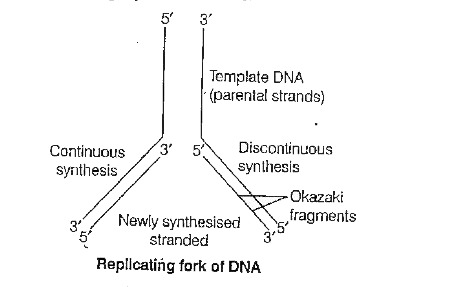Explain the process of DNA replication with the help of a diagram. In which phase of the cell cycle does it occurs in eukaryotes ? What would happen if cell division is not followed after DNA replication ?Solution in Odia
DNA replication takes place during S-phase of interphase in cell cycle. DNA replication is semiconservative process. In this process
(i) The two strands of the parent DNA molecule separate.
(ii) Complementary strands are synthesised using old strands as template.
Each progeny strand has one old and one new strand

Requirement for DNA Replication
• DNA template .
• A primer (usually RNA)
• Deoxyribonucleotide triphosphate (i.e. ATP, dGTP, dTTP, dCTP)
• Mg2+
• DNA unwindiwing proteins (helicase and gyrase).
• RNA polymerase to synthesise the RNA primer .
• DNA polymerase (a DNA synthesising enzyme )
DNA replication is bidirectional. A replicon is the segment of DNA which is capable to perform DNA replication and independent of other segments of DNA replication and independent of other segments of DNA . Each replicon has an origin of replication, at which DNA replication starts and a terminus, at which replication stops.
The two strand of DNA double helix unwind with the help of DNA unwinding proteins (e.g. DNA gyrase and DNA helicase) . Unwinding proteins produces two Y-shaped forks at origin, one fork is located at each end of the origin. When replication begins, these forks become replication forks.
The unwinding of the strands imposes by the action of a superhelix relaxing protein. Single Stand Binding Proteins (SSBPs) stabilise the unwound parental DNA Initiation of DNA synthesis requires an RNA primer. RNA primer is synthsised on DNA template by an enzyme primase
The free 3.→OH of primer RNA provides the initiation point of DNA polymerase, which requires a free 3. - OH of a pre-existing polynucleotide for the initiation of DNA replication. DNA replication is semiconservative, semidiscontinuous , which occurs always in 5.→3. direction . Replication of 3.→5. strand of a DNA molecule proceeds continuously therefore , the 3.→5. strand of DNA molecule is known as leading strand. The replication of
5.→3. strand of the DNA molecule is discontinuous and is known as lagging strand. Replication of lagging strand generates small nucleotide fragments in 5.→3. direction called Okazaki fragments.
After DNA replication, DNA content in a cell gets double. Thus, if cell division is not followed after replication then increased DNA/chromosome content will lead to polyploidy condition.
Topper's Solved these Questions
- BOOK - ARIHANT PRAKASHANCHAPTER - VERY SIMILAR TEST 3 EXERCISE - Section B (Zoology) Group A10videos
VERY SIMILAR TEST 3
- BOOK - ARIHANT PRAKASHANCHAPTER - VERY SIMILAR TEST 3 EXERCISE - Section B (Zoology) Group B9videos
VERY SIMILAR TEST 3
- BOOK - ARIHANT PRAKASHANCHAPTER - VERY SIMILAR TEST 3 EXERCISE - Section A (Botany) Group B9videos
VERY SIMILAR TEST 3
- BOOK - ARIHANT PRAKASHANCHAPTER - SEXUAL REPRODUCTION IN FLOWERING PLANT EXERCISE - CHAPTER TEST20videos
SEXUAL REPRODUCTION IN FLOWERING PLANT
- BOOK - ARIHANT PRAKASHANCHAPTER - VERY SIMILAR TEST 1EXERCISE - Section - B (Zoology)26videos
VERY SIMILAR TEST 1
Similar Questions
Name the scientists who developed the first transgenic mice
03:52View SolutionWhat are molecular diagnostic techniques ?
02:35View SolutionParthenocarpic tomato fruits can be produced by:
View SolutionThe thick swollen embryonal leaf filled with reserve food is called
04:09View SolutionChoose the correct answer from the choices given under each bit/Give the answer in one word only :
Which organism is used as the cloning host cell to produce humulin ?01:42View Solutiona) Explain the process of DNA replication with the help of a schematic diagram.
b) In which phase of the cell cycle does replication occur in Eukaryotes? What would happen if cell-division is not followed after DNA replication?01:04View SolutionWhat will happen if DNA replication is not followed by cell division in a eukaryotic cell?
02:28View SolutionIn which stage of cell cycle, DNA replication occurs:
05:58View SolutionPhase of cell cycle unique for DNA replication is ……………
03:19View SolutionReplication of DNA occurs at ……………….. phase of cell cycle.
01:17View SolutionWhen DNA replication does takes place in cell cycle of eukaryotes?
04:49View SolutionWhat type of DNA polymerase helps mitochondrial DNA replication in eukaryotic cells?
01:04View Solutiona) Explain the process of DNA replication with the help of a schematic diagram.
b) In which phase of the cell cycle does replication occur in Eukaryotes? What would happen if cell-division is not followed after DNA replication?View SolutionWhat will happen if DNA replication is not followed by cell division in a eukaryotic cell?
02:35View SolutionDNA replication takes place at ________ phase the cell cycle.
02:12View Solution
